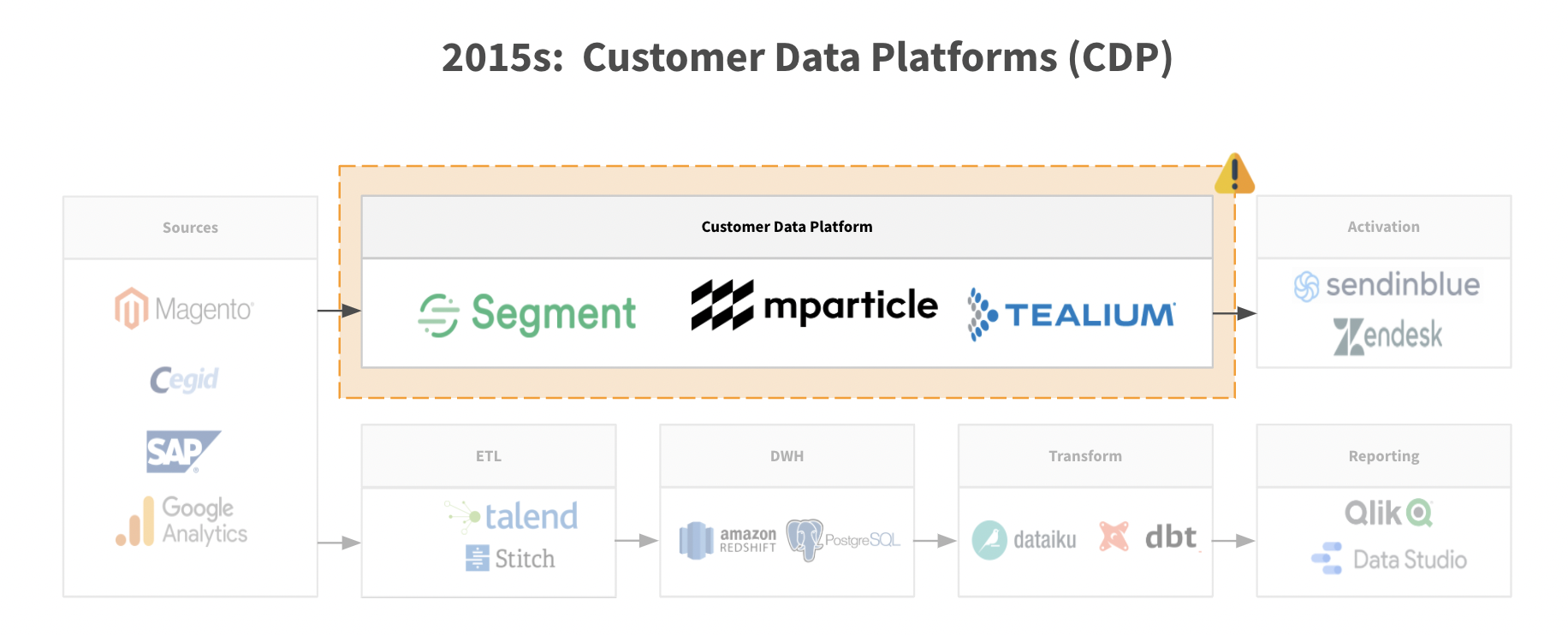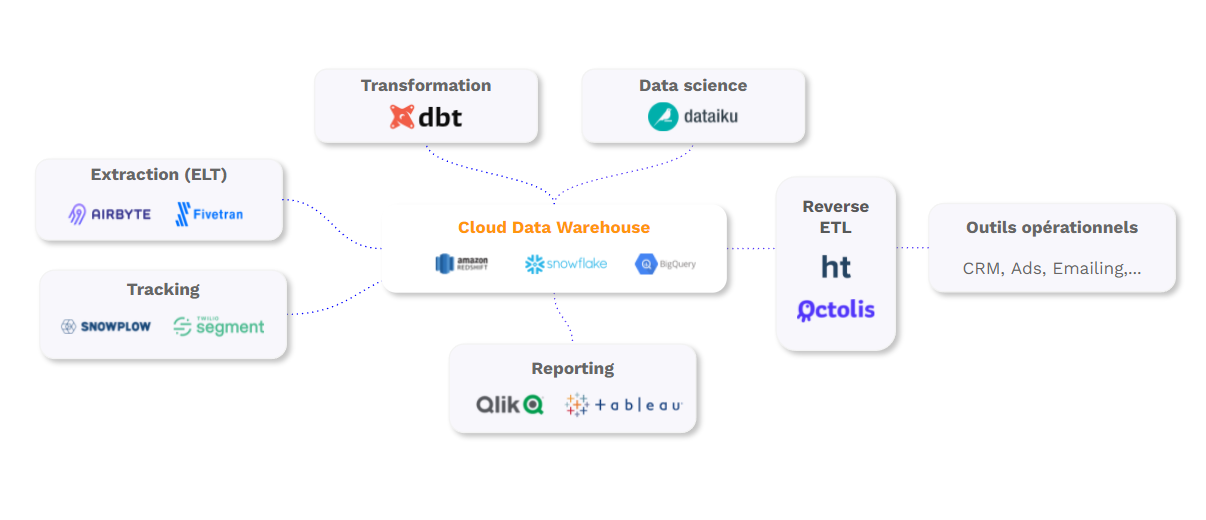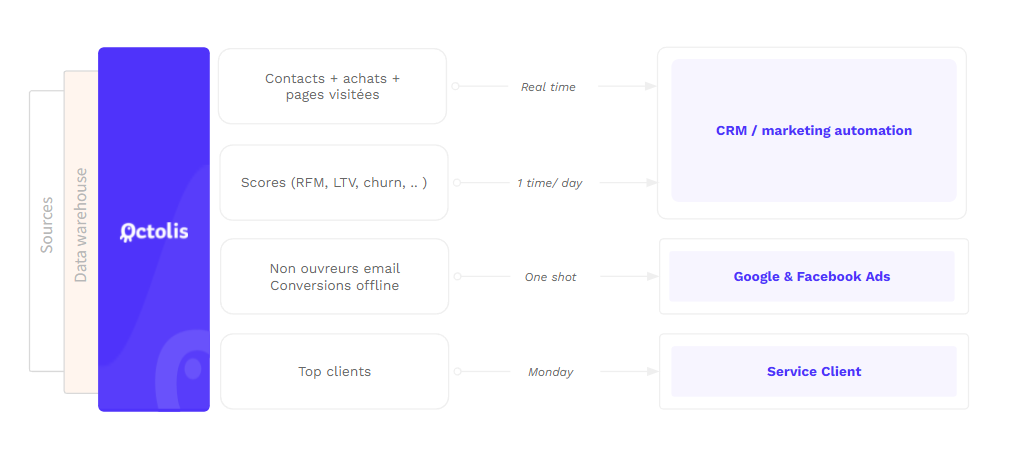A Customer Data Platform is an off-the-shelf technology designed to connect, unify and activate your customer data.
As a modern customer data management solution, CDPs have a significant advantage over competing solutions on the market: their ease of use. Their user-friendly interface allows business users to manipulate data almost autonomously. CDP’s combine functional power with ease of use.
In the first chapter of this guide, we will provide a definition of CDPs. We will then look at what distinguishes CDPs from other data management technologies that you are probably familiar with: CRM, DMPs and other data warehouses… We will end by highlighting the 4 main reasons for deploying a CDP today.
📕 Contents
Customer Data Platform (CDP): Definition
What is a Customer Data Platform (CDP)?
A Customer Data Platform, as the name suggests, is a software solution for managing customer data. Let’s recall the canonical definition from Gartner:
“A CDP is a marketing technology used to unify customer data from marketing and all other channels in order to build customer profiles and optimise the timing and targeting of messages and offers”.
The Customer Data Platform is therefore :
- A database in which customer data from different tools/sources within the company is unified. The data is unified around a unique ID that allows for persistent and exhaustive customer profiles: the famous 360° customer vision.
- A laboratory (a “refinery”) that transforms customer data** before redistributing it to the activation tools: normalisation, de-duplication, cleaning, enrichment, segmentation, construction of aggregates, scoring, etc.
It should be noted that a CDP essentially manages first-party data, i.e. data collected by the company itself at its various points of contact with customers: transactional data, behavioural data, demographic data, etc. It is however possible to enrich a CDP with third-party data. We will come back to this point.
The functional characteristics of Customer Data Platforms
Customer Data Platforms therefore have a triple function:
- Aggregate customer data from all sources and all the company’s contact points.
- Transform customer data and unify it around a customer profile.
- Activate this transformed and unified data via activation tools.
All CDPs fulfil this triple function. They differ from each other in the functional depth offered at each of these stages.
Let’s go a little further into the functional description of CDPs. A good Customer Data Platform is a technology that :
- Provides a Single Customer View**. Data is unified to build a complete, 360° view of the customer. In other words, it gives a user the ability to access all the data relating to a customer on the same human-machine interface.
- Makes possible an omnichannel customer experience**, homogeneous on all offline and online channels. Unification of data from all sources enables the construction of omnichannel relationship programmes and scenarios.
- Breaks down data silos**. Customer data tends to be scattered throughout the organisation and compartmentalised in the different software used. It is this fragmentation that prevents the full exploitation of customer data. By connecting all data sources, a CDP solves this classic problem.
- Allows you to become truly customer-centric**. Unification of data leads to better customer knowledge. By becoming customer data-driven, teams can finally deploy customer-centric actions, campaigns and scenarios.
- Optimises the productivity of business teams**. A CDP facilitates and partially automates data processing. Thanks to the connectors and APIs offered by these platforms, it becomes quick and easy to create audience segments and other aggregates. This allows operational teams to focus on value-added operational tasks.

Position of the Customer Data Platform in the Customer IS ecosystem.
The skills required to use a CDP
Customer Data Platforms are off-the-shelf solutions with user-friendly interfaces. This is one of the main value propositions of a CDP, one of the main differentiators from other data management technologies. A CDP is designed for business teams.
The IT department is involved in the initial configuration of the software and occasionally in connecting data from sources for which there is no connector (Json imports, APIs). But it is then the marketing teams and other business teams that have the upper hand on the tool. A CDP democratises access and exploitation of customer data, reducing the business’ dependence on IT.
The short History of CDPs
Customer data management is not a new subject. Technologies to centralise and transform customer data have long been available. But the arrival on the market of Customer Data Platforms and cloud-based data infrastructures (cloud data warehouses) in the late 2010s has changed the game profoundly, in a good way. These modern technologies have several decisive advantages. They are :
- Much easier to manage. No need for a battery of data engineers to maintain a CDP. Modern data solutions are designed to be used autonomously by operational teams.
- Much cheaper. The cloud has made storage a commodity. Storage costs have plummeted. Cloud data warehouses (which allow you to build a bespoke CDP) have an additional advantage over off-the-shelf CDPs: the decoupling of storage costs from computing costs. This pricing model has driven down costs.
- Much more powerful. Computing power is incomparably higher than what past technologies offered.
The graph below, provided by Treasure Data, gives an overview of the evolution of data management technologies.

Source : Treasure Data
What distinguishes a CDP from a good old CRM or DMP? That’s what we’re going to look at now!
CDP compared to other data management systems: DMP, CRM, Datawarehouse
CDP vs. DMP
DMPs are “Data Management Platforms”. DMPs appeared in the 2000s and were designed to manage online advertising campaigns, then retargeting campaigns based on browsing cookies. A DMP makes it possible to create audiences based on several attributes. These audiences or segments are then activated in media, on digital channels.
The data in a DMP is, by design, anonymous and ephemeral. The Data Management Platform uses third party data from specialized suppliers and SSP/DSP type platforms. It does not allow the creation of persistent customer profiles and therefore, a fortiori, the construction of a 360° customer vision.
A “media” oriented DMP can therefore hardly be used as a Customer Data Platform. A DMP is not intended to be a single customer repository used to optimise customer relations at all online and offline contact points. A DMP is a tool for advertisers and its use is for advertising.
To qualify this, it should be noted that some CDPs on the market are in fact former DMPs, converted DMPs. These “customer-centric” DMPs integrate “first-party” CRM data and enable customers to be retargeted in online campaigns. There is therefore a clear link between DMPs and CDPs.
In a context of tightening personal data management rules (RGPD…), companies are led to refocus on first-party data… and therefore on CDPs rather than traditional DMPs.
CDP vs CRM
A CRM is the traditional software used to centralise the management of customer interactions. More than an activation tool, a CRM has also since its inception been used as the main customer database. A CRM stores contact information, socio-demographic data (and firmographic data, in B2B), relationship history, purchase history, possibly data from questionnaires and other declarative data as well as transactional data (more often managed by an ERP).
But a CRM, unlike a CDP, is not designed to manage large volumes of data. It is not designed as a database. In particular, a CRM still does not handle digital and semi-structured data very well and cannot connect to all data sources. For this reason, CRM software cannot act as a single customer repository. It cannot unify all data and create the omnichannel customer view that is now needed.
To qualify this, we are talking about mid-market CRMs. The CRM giants (Salesforce, Microsoft Dynamics) offer very rich ecosystems that can manage all online and offline channels.
CDP vs Datawarehouse
It is important to be precise about the terms we use. A Customer Data Platform actually means two things:
- The “off the shelf” solutions that define themselves as CDP.
- Cloud infrastructures that allow you to build a unified customer data management platform, without defining themselves as CDPs. However, these infrastructures, combined with other tools, do make it possible to build a CDP, and a tailor-made one at that. Functionally speaking, they are CDPs.
The second definition refers specifically to cloud datawarehouses, BigQuery, Amazon Redshift, Firebolt and Snowflake. A modern datawarehouse is a cloud infrastructure that can store and unify any structured and semi-structured data. If this data is customer data, then the data warehouse, in combination with a Reverse ETL tool, has the same function as a Customer Data Platform.
The data in the data warehouse is loaded via ETL tools that extract the data from the various sources, transform it to fit the data models in the warehouse and then load it into the data warehouse. So Extract – Transform – Load. More and more often, data is transformed after being loaded into the warehouse via dedicated solutions (such as DBT). ETL tools are therefore becoming lighter and more like EL tools, without the T.

The modern data stack: a set of software bricks forming an ecosystem to better collect, transform and activate customer data.
Cloud datawarehouses (DWH) are becoming more powerful, more affordable and easier to install and manage. As a result, they are becoming very serious competitors to off-the-shelf CDPs. Building a CDP from a datawarehouse creates a unified database separate from the software. This is the strength of this architecture option. It offers greater control over the data and greater freedom in how the data is organised (no imposed by design data models). The DWH is the central brick of the modern data stack.
Find out why you should use your data warehouse to play the CDP role.
Why implement a Customer Data Platform?
The Customer Data Platform is an answer to several issues and problems. We see at least 4 reasons to deploy a CDP in your organisation.
#1 To comply with the increasingly strict data protection regulations
The rules on personal data protection are becoming more and more stringent. We are thinking in particular of the European Data Protection Regulation or RGPD, which came into force in May 2018. Personal data can no longer be stored, processed and used in any way.
To ensure compliance with RGPD-like regulations, companies must implement Data Governance. Data governance means having control over your data and ideally having unified data. It is more difficult to implement effective governance when data is scattered across dozens of tools, software and databases.
Data unification allows you to have control over all the data in the company and to apply rules and treatment processes centrally. A concrete example to illustrate: if one of your customers demands (and it is his right) that you delete all the data that your company has on him, the fact that you have unified all his personal data allows you to respond much more quickly to his request than if the customer’s data were dispersed in 15 tools.
In fact, this governance and compliance issue is sufficient to justify a customer data unification project and therefore consider deploying CDP-type technology. It should be remembered that a company that does not comply with the RGPD can be fined up to several million euros. RGPD compliance is not an option.
Check out our full benchmark of modern data stack tools.
#2 To better exploit digital data and process data in real time
More and more customer data is digital data, i.e. data collected or extracted from online customer journeys: website data, ecommerce data, data from online advertising campaigns, data from SaaS, etc. Customer journeys are becoming increasingly digital.
This data from digital channels and contact points must be exploited, i.e. collected, unified and activated.
However, CRMs do not manage this web data well, unlike CDPs, which can unify all data from all offline and online sources. Web data is mostly behavioural data (“events”) that informs about the immediate needs and expectations of customers: pages visited on the website, activity on social networks, etc.
To be exploited, in Marketing Automation scenarios for example, this data must be activated quickly. Web data processing implies real time or near real time…which, once again, CDPs make possible.

- The Octolis Lightweight CDP makes it possible to exploit web data in real time through Marketing Automation.
#3 To achieve hyper-personalization of communications, content and offers
Customers want to be treated as what they are: unique individuals with unique needs and expectations. When they receive offers from you, they want them to be personalised.
Capturing the attention of customers who receive dozens or even hundreds of solicitations a day is becoming increasingly difficult. It is the personalisation of communications, offers and content that makes it possible to stand out and capture this attention.
Hyper-personalisation refers to the ability to send the right offer to the right customer, at the right time, on the right channel.
The personalisation of customer marketing requires a detailed knowledge of the customer. It is customer data that makes this customer knowledge possible. Having a technology for unifying customer data makes it possible to enrich customer knowledge and therefore the relevance of marketing solicitations – all in a largely automated manner. CQFD. CDPs enable 1:1 personalisation to be scaled through powerful data orchestration.
#4 To accommodate the end of third party cookies
As mentioned above, the end of third-party cookies and other pixels requires a refocusing on first-party data, i.e. data collected directly by the company at the various contact points it offers to its customers. The Customer Data Platform is dedicated to the management of this first-party data, even if connectors allow this data to be enriched. Data-driven marketing will increasingly be first-party data-driven marketing.
A CDP is the solution to collect more and better first party data…and to exploit this same data more and better.
Conclusion
The Customer Data Platform is the modern technology for unifying and effectively leveraging customer data. Companies have never had so much customer data at their disposal, but their dispersion in tools prevents them from exploiting its full potential.
The challenge now is to organise this customer data. The ability of CDPs to meet these challenges justifies the market’s enthusiasm for these solutions.
To find out more, read our article “For a paradigm shift in the Customer Data Platforms market“.


